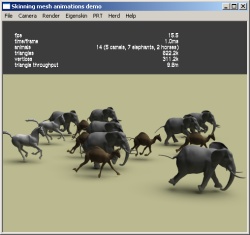Skinning Mesh Animations demo

This is a demo of our skinning mesh animations approach. In this application, you can view the various skinned mesh animations and see how things like increasing the number of eigenskin corrections or turning off view-dependent LOD affect the quality and framerate of the animation.
Note that the timings in our paper were obtained on a very specific graphics card and computer combination; your mileage may vary.
In order to run the demo, you will need to obtain one or more of the binary skinning files below. For those who are interested, we will be posting information on reading the binary format shortly.
Update (March 3, 2007): The demo can now also read in skin in the basic text data format described here. Of course, these skins don't support PRT lighting; I will hopefully get around to releasing my PRT lighting tool eventually to enable this as well.
For further information about Skinning Mesh Animations, please see our paper.
- Demo application, Windows (zip; 4.6MB)
.skin files
The first group of skins are all based on Robert Sumner's Deformation Transfer data. If you are interested in obtaining any datasets in obtaining that appear in our paper but not here, please contact Christopher Twigg.
The chicken character was created by Andrew Glassner, Tom McClure, Scott Benza, and Mark Van Langeveld. This short sequence of connectivity and vertex position data is distributed solely for the purpose of comparison of geometry compression techniques.
You will need to download both the .skin file and the texture map to make this work. The texture map was created by Moshe Mahler.
- Chicken crossing (8.9MB)
- Texture map (9KB)
Demo instructions
To get started, simply run the application and load in a
.skin file. You will see a small herd of animals
running in front of you.
To increase the number of animals, either press the + key on
your number pad, or select 'Herd → Properties...'.
To decrease the number of animals, either press the - key on
the number pad, or select 'Herd → Properties...'.
The animals will run in place unless you check 'Herd →
Moving'. Note that this doesn't make much sense for some
skinned meshes, such as the chicken.
To step through the animation frame by frame, uncheck 'Herd
→ Running' and use the [ and ]
keys to step forward and backward.
You can explore the different levels of detail through the
'Render → LOD' submenu. You
can change the number of Eigenskin vertex and normal corrections
through the 'Eigenskin' menu (see our paper for more
details); note that the Eigenskin normal corrections only apply
to OpenGL lighting. Switch between OpenGL and PRT lighting
through the 'Render → Lighting' menu.
Either Vertex Buffer Objects (VBOs) or display lists may be faster on your
particular hardware/driver configuration, experiment with both through the
Render → Method' submenu.
You can open multiple .skin files at once (e.g.,
elephants and horses) by selecting both at once in the
File → Open... dialog.
Please contact us if you have any questions about the demo or the techniques used.